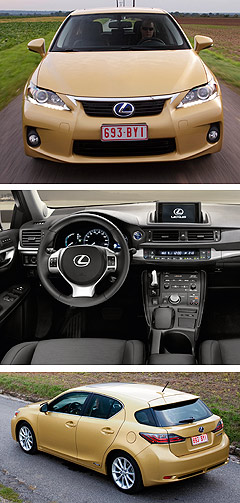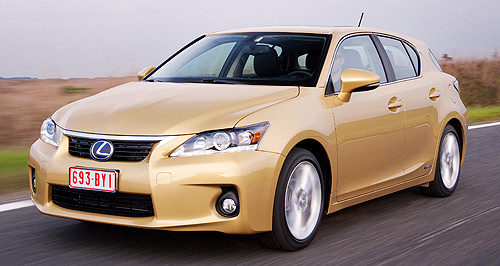Future models - Lexus - CT - 200hFirst drive: Lexus lobs hybrid hatchbackEco-friendly: European versions of the all-new Lexus CT200h will emit as little as 87g/km of CO2. Lexus to improve super-frugal new CT200h’s ride quality before it hits Oz26 Oct 2010 LEXUS has vowed to reduce the noise, vibration and harshness (NVH) levels of its first luxury hatchback before the groundbreaking new CT200h goes on sale here as Lexus Australia’s first dedicated hybrid model early next year. Tyre noise and ride quality emerged as two undeniable causes for concern on the extremely coarse-chip rural roads chosen for the global launch of the all-new CT hybrid outside Paris earlier this month, when broken bitumen road surfaces blighted our first drive of the vital new entry-level Lexus model. Chief engineer Osamu Sadakata countered criticism of the CT200 from Australian journalists by insisting the small five-door’s NVH levels were no worse than key rivals on the unusually rough French pavement, which in some construction zones was littered with sharp-edged potholes and protruding manhole covers. But he conceded that cabin noise and vibration in the CT – which will be sold in three specification grades starting at less than $50,000 in Australia, including the mid-range F Sport variant that made its world debut at this month’s Sydney motor show – could and would be improved before the car enters production in Japan in December. “CT200h is not inferior to its competitors in terms of noise and vibration,” said Mr Sadakata. “I actually had a similar experience. The road doesn’t look as rough as it actually is. If we had rivals here they would be noisy, too. “I wouldn’t say the CT was very quiet on the type of roads you covered this morning. (But) we will continue to improve and will pursue the best set-up. “We are determined to study what was wrong with the car on the road today so we can further improve the vehicle. We will reduce road noise,” he said. The pre-production US and European-specification CTs we drove came with pronounced tyre roar that made normal conversation impossible inside at most speeds, and with suspension resonance that could be felt through the driver’s footwell and pedals. Despite the “world-first” fitment of front and rear cross-chassis dampers to quell chassis vibration, NVH levels in the CTs we drove seemed worse than in many non-luxury small cars we have driven. The lack of a now-common soft-touch automatic lane-change indicator function, a foot-operated (instead of an electric or at least hand-operated) parking brake and overly large, low-resolution graphics on the dashboard’s large colour touch-screen also surprised us. And no, the front-wheel drive CT200h does not set new dynamic or performance benchmarks in the highly competitive premium C-car segment, which includes formidable rivals like BMW’s (for now) rear-drive 1 Series and the front- and all-wheel drive Audi A3. But there are a number of compelling reasons for potential customers to buy the smallest ever Lexus, chief among them fuel consumption and emissions.  Australians will not be offered Europe’s super-frugal entry-level model, which emits a Prius-beating 87 grams of CO2 per kilometre and consumes a Prius-bashing 3.8 litres of petrol per 100km, making it 20 per cent more fuel efficient than its nearest competitor. What’s more, it produces only 3mg of harmful NOx gas per kilometre and none of the particulate matter emitted by its most direct diesel rivals. Australians will not be offered Europe’s super-frugal entry-level model, which emits a Prius-beating 87 grams of CO2 per kilometre and consumes a Prius-bashing 3.8 litres of petrol per 100km, making it 20 per cent more fuel efficient than its nearest competitor. What’s more, it produces only 3mg of harmful NOx gas per kilometre and none of the particulate matter emitted by its most direct diesel rivals.However, with standout figures of around 96g/km and 4.1L/100km, the Australian-spec CT will still be the most efficient and therefore environmentally friendly small luxury car available here. We averaged around 6.5L/100km during a spirited first drive on French B-roads and freeways, which is not outstanding but makes Lexus’ claimed fuel consumption figures plausible around town, where Prius-like hybrid features like an idle-stop system and a 2km EV-only driving range most effectively reduce fuel consumption. The CT is no slouch, delivering reasonably spritely acceleration – after a disconcerting momentary pause while the front wheels switch from being driven by the 60kW electric motor to the 73kW 1.8-litre Atkinson Cycle engine – both during full-throttle standing starts and open-road passing manoeuvres. You’ll have to pick the right road to attempt the latter, however, because although the Lexus adds its own specific intake and exhaust hardware, it employs the same hybrid drive system as the Prius, which means that – at least until Lexus develops a higher-performance plug-in version – the CT200h is no BMW 130i. Grab the proper pull-type doorhandles and all five of the CT’s doors clang home like they do on a Prius, too, but that’s about where the similarities with Toyota’s hybrid hero end. Appearing much better in the metal than in pictures but nowhere near as aggressive as the motor show concept that previewed it, the CT looks stylish, edgy and purposeful in ways the 1 Series and A3 (not to mention the Mini and Mercedes B-class) do not, but remains an unmistakable member of the Lexus family. The cars we drove came highly specified with LED low-beam tail-lights, daytime running lights and headlights (for a total of 89 LEDs), front and rear parking sensors, a rearview camera, rear hatch spoiler, indicators in the wing mirrors, 17-inch multi-spoke alloys with 215/17-section Michelin tyres, a chromed grille with large ‘L’ mascot and discreet blue ‘Hybrid’ and ‘CT200h’ badging. Inside, the all-new CT cabin is a highly ergonomic environment, featuring classy stitched and perforated leather (or textured cappuccino-coloured fake suede in some models) armrests and seats – the latter with full power adjustment and three-position memory for the driver – plus a small thick-rimmed LFA-style three-spoke steering wheel with remote audio, phone and cruise controls. Other cabin features include push-button starting, dual-zone climate-control, heated front seats and four one-touch power windows. There’s also a (potentially optional) large colour touch-screen that flips up from the centre of the dash, which can also be operated via the ‘Remote Touch’ mouse-style controller first seen in the RX400h and combines all infotainment functions, while the top-notch sound system comes with USB and 3.5mm auxiliary music device inputs. While front passengers are pampered – with the exception of the centre armrest being too far back for us – leg, head and shoulder room in the rear can only be described as tight for two adults and, like a lot of premium hatchbacks (BMW’s 1 Series included), the heavily humped centre rear position is suitable only for kids. This is despite the lack of a central ski-port, although unlike some battery-assisted cars the CT’s rear seatback has a 60/40 split-fold, making the smallish cargo space more flexible. There’s a temporary spare wheel/tyre underneath the fully lined and illuminated boot, as well as plenty of cargo hooks and a flush loading lip. The highlight of the luxurious CT interior, however, is a futuristic instrument panel featuring a cool blue illuminated background, which switches to red and displays a large central tacho when you select ‘Sport’ mode via the console-mounted rotary dial. While maximum power is always available when you floor the accelerator pedal, sport mode stiffens the steering, sharpens throttle response, raises the electronic stability control’s intervention threshold and increases the electric motor’s peak output from 500 to 650 volts, making a noticeable improvement to part-throttle acceleration. However, we wait with interest a more powerful version of the CT, because its tight chassis feels like it can handle considerably more power. Sweet, vice-free steering and well-sorted body control are highlights, combining to make the CT a far more rewarding drive than the Prius, which feels flimsy and unrefined in comparison. There’s plenty of grip on offer, too, allowing you to bury the CT’s nose deep into corners and change direction without excessive bodyroll and with an alacrity unmatched by any other Lexus. The firmer suspension tune of the Euro-spec model we drove was best described as jiggly, however, and as with all front-drive vehicles understeer sets in at the limit of adhesion, requiring you to back off in bends that a BMW hatchback would accelerate unflinchingly through. The CT200h represents an undoubted step up from the benchmark-setting Prius in every respect, yet manages to offer more performance, better handling, more luxury and spades more style while being virtually as efficient. If Lexus can fix the unacceptable tyre noise in the pre-production models we drove in Europe, there’s no reason the CT won’t tempt significant numbers of younger buyers who desire a small luxury hatchback that offers unrivalled running costs and environmental credentials.  Read more15th of October 2010  Sydney show: Lexus goes F-madLexus stages world CT200h F Sport debut and confirms $700K LFA supercar is sold out4th of October 2010  Lexus plans quicker CTHigher-performance version of the CT200h hybrid on the cards4th of October 2010  Lexus CT200h from under $50KSub-$50,000 starting price confirmed for all-new Lexus CT200h in AustraliaAll future models Alfa Romeo Alfa Romeo Abarth Abarth Audi Audi Aston Martin Aston Martin BMW BMW Bentley Bentley Chrysler Chrysler Chevrolet Chevrolet Dodge Dodge Citroen Citroen Ferrari Ferrari DS DS Ford Ford Fiat Fiat FPV FPV Foton Foton Haval Haval Great Wall Great Wall Honda Honda Holden Holden Hyundai Hyundai HSV HSV Isuzu Isuzu Infiniti Infiniti Jeep Jeep Jaguar Jaguar Lamborghini Lamborghini Kia Kia Lexus Lexus Land Rover Land Rover Mazda Mazda Maserati Maserati Mercedes-Benz Mercedes-Benz McLaren McLaren Mini Mini Nissan Nissan Mitsubishi Mitsubishi Peugeot Peugeot Opel Opel Proton Proton Porsche Porsche Renault Renault Ram Ram Saab Saab Rolls-Royce Rolls-Royce Smart Smart Skoda Skoda Subaru Subaru SsangYong SsangYong Tesla Tesla Suzuki Suzuki Toyota Toyota Volvo VolvoCT pricing
Motor industry news |
Click to shareLexus modelsResearch Lexus All future models Alfa Romeo Alfa Romeo Abarth Abarth Audi Audi Aston Martin Aston Martin BMW BMW Bentley Bentley Chrysler Chrysler Chevrolet Chevrolet Dodge Dodge Citroen Citroen Ferrari Ferrari DS DS Ford Ford Fiat Fiat FPV FPV Foton Foton Haval Haval Great Wall Great Wall Honda Honda Holden Holden Hyundai Hyundai HSV HSV Isuzu Isuzu Infiniti Infiniti Jeep Jeep Jaguar Jaguar Lamborghini Lamborghini Kia Kia Lexus Lexus Land Rover Land Rover Mazda Mazda Maserati Maserati Mercedes-Benz Mercedes-Benz McLaren McLaren Mini Mini Nissan Nissan Mitsubishi Mitsubishi Peugeot Peugeot Opel Opel Proton Proton Porsche Porsche Renault Renault Ram Ram Saab Saab Rolls-Royce Rolls-Royce Smart Smart Skoda Skoda Subaru Subaru SsangYong SsangYong Tesla Tesla Suzuki Suzuki Toyota Toyota Volvo VolvoCT pricing
Motor industry news |
















Facebook Twitter Instagram